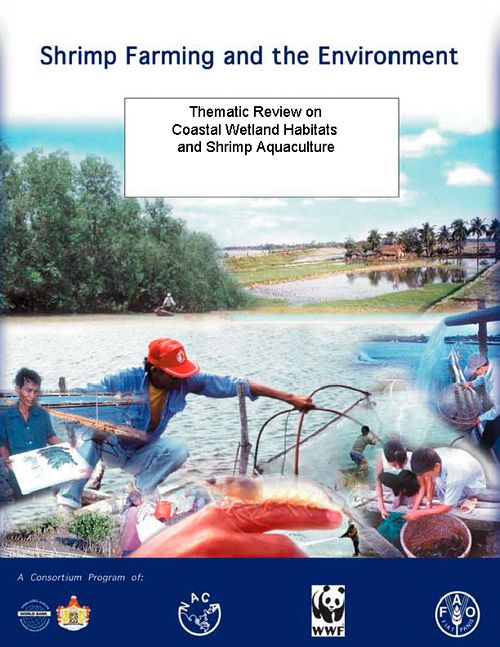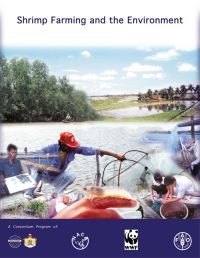Thematic review on coastal wetland habitats and shrimp aquaculture
31 May 2005 | Roy R. "Robin" Lewis III, Michael J. Phillips, Barry Clough and Donald J. Macintosh | 1223 Downloads | .pdf | 1.58 MB | Better management practices, Genetics and Biodiversity, Governance and Policy, Livelihoods, gender and social issues, Aquatic plants, Shrimp
Interactions between coastal wetland habitats, particularly mangroves, and shrimp aquaculture, have received considerable attention in recent years. The review begins by documenting the status of shrimp aquaculture in relation to mangrove forest ecosystems. The environmental, social and economic impacts of shrimp farming are discussed, with examples covering both the negative and positive aspects of the sector.
The main section of the review considers interventions and other activities to improve the sustainability of shrimp farming in the context of coastal zone management and the protection of mangrove ecosystems. Over the past decade, understanding of the relationship between shrimp farming and the environment have led to various efforts to mitigate the negative impacts of aquaculture on coastal habitats. These include: zoning schemes to confine aquaculture outside wetland conservation areas; changes in farm management practices; introduction of new legislation to protect the environment (e.g. controls on farm effluent discharge); initiation of dialog among shrimp farmers through forums such as farmers societies and associations, and dialogues with non-governmental sectors, increased research and development efforts.
The effectiveness of these interventions is considered here in the light of experience based on case studies. A format for the case studies was prepared at a workshop held in Bangkok, Thailand on 14th – 16th February 2000. The expert group invited to the workshop also identified a list of potential case studies for this thematic review and considered how information from each case study should be incorporated into the synthesis. The case study analyses highlight the effectiveness of efforts made, the underlying reasons for successes or failure, their strengths and weaknesses, and identify where research and other further efforts are most required. The 14 case studies used to support this synthesis are provided in a separate Annex. Some of the case studies are based on country level experiences; others are more specific to a particular locality where there is a record of good environmental management related to shrimp farming.
This review document, together with the case studies, attempts to cover the following major questions and issues related to shrimp farming and coastal wetland habitats:
- What are the major interactions between shrimp farming and coastal wetlands? Is it possible to estimate the mangrove habitat damage from the industry/sector in terms of direct and indirect economic loss, employment, social implications, etc.?
- What strategies are being used to rehabilitate both shrimp ponds and coastal wetlands? Which strategies are most compatible/complementary? What are the major issues and what can be learned from these experiences? Is it possible to develop a set of ‘best practice’ guidelines for the rehabilitation of coastal wetlands and shrimp ponds?
- What are the experiences regarding the management of clusters of farms/ponds, to mitigate impacts and ameliorate environmental conditions at the medium scale? In particular, what are the experiences regarding management of water flows/cycles in larger wetland bodies?
- What are the experiences regarding co-existence of shrimp/aquaculture production areas and wetland nature reserves and multiple use conservation parks? What are the links to community management and the sustainable multiple use of resources under such schemes?
- What are the social, economic, and institutional issues to consider? How can pond and wetland habitat rehabilitation efforts be best integrated into coastal area management programmes?
- What farming systems, technologies and management practices should be considered for aquaculture in coastal mangrove and other wetland habitats? How successful have mixed aquaculturesilviculture farming systems been? What lessons can be learned regarding the scope for further interventions to promote the coexistence of shrimp aquaculture and coastal wetlands?
- What are the options for promoting coastal (aquatic) polyculture systems, in combination with mangroves and other coastal wetlands?
- What is known about the biodiversity in areas that have been fully or partially denuded of
- Mangroves, and similar areas where mangroves are still intact?
- Are there any working models demonstrating that coastal aquaculture, especially shrimp farming, can exist within rather than supplanting the mangrove forest area?
- What are the key issues and needs for further development of best practices for shrimp aquaculture development in coastal habitats?
Copyright, all rights reserved.

